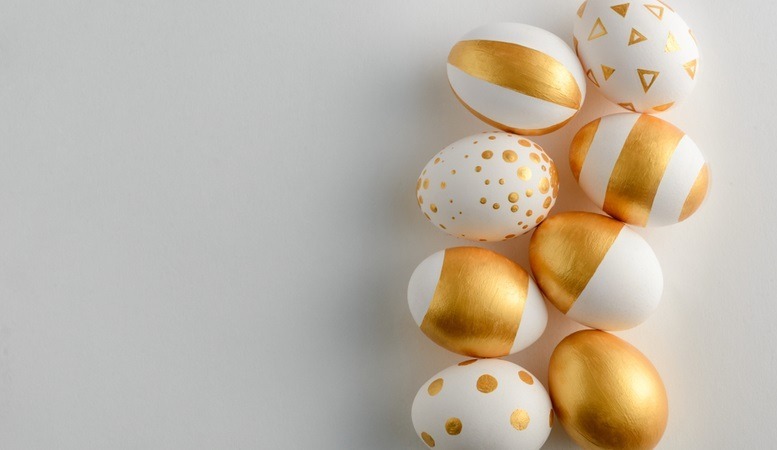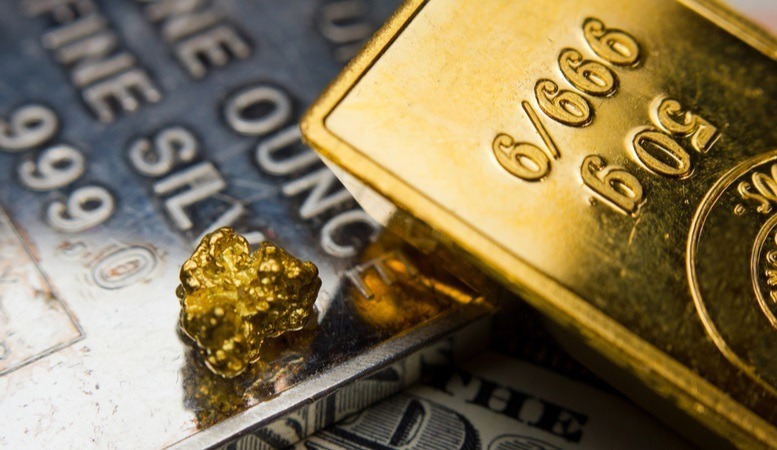Table of Contents
Planning for the future requires a strategic mindset. Certain retirement investments offer excellent returns but come with the risk of large losses, while safer options tend to have a much lower rate of return.
Many people stick with their employer-led 401(k) or 403(b) investment vehicles. Still, these have several drawbacks, including high fees and few investment opportunities.
The most popular alternative is the Individual Retirement Account (IRA). Traditional IRAs allow you to invest in stocks, bonds, and other securities, while self-directed IRAs focus on investing in physical gold, precious metals, and other tangible assets.
It’s always worthwhile to explore all of your options when planning for retirement. Our deep dive into gold IRAs will help you discover the benefits and drawbacks of this option and decide whether it’s the right choice for you.
What Is a Gold IRA, and How Does it Work?
A gold IRA works like a traditional IRA account. However, instead of investing in bonds and stocks, you invest in precious metals such as gold, platinum, and palladium. In addition to buying physical precious metals, with gold IRAs, you can also buy:
- Mutual funds that invest in gold bullion
- Gold exchange-traded funds (ETFs) that track gold indexes
- Gold stocks that include shares in gold mining companies and gold production companies
How Does Gold IRA Investing Work?

The only difference between a self-directed gold IRA and a traditional IRA is that a self-directed IRA gives the investor access to a broader range of investment options. Self-directed IRAs can invest in precious metals, real estate, and physical assets, such as art collections and livestock, but function the same as regular IRAs.
What this means in practical terms is that contributions to a gold IRA are still tax-deductible (up to $6,000 per year, or $7,000 per year for people over 50), or you can opt for a tax-free distribution when you start accessing your retirement funds.
The same restrictions that apply to regular IRAs also apply to a gold IRA. If you decide to withdraw funds from your account before you turn 60, you’ll suffer a tax penalty of 10% and a potential capital gains tax if your precious metals increase in value while in the self-directed IRA.
The IRS does allow some exceptions to the 10% premature withdrawal penalties, such as withdrawing funds for educational purposes or a deposit for a first-time home purchase.
In day-to-day terms, most people don’t notice the difference between investing in a gold IRA account and a traditional one. You’ll still follow the same procedures of placing funds into the account, receiving a quarterly statement and online balance reports, and will still be subject to the same rules and regulations as other IRA options,
The Advantages of a Gold IRA
Many people are comfortable with their current investment strategy of putting money into a 401(k) or investing in a traditional or Roth IRA. Why make the change and start investing in gold? Here are some excellent reasons to invest in a self-directed IRA, such as a gold IRA through the Oxford Gold Group.
Portfolio Diversification
The main reason for considering a traditional gold IRA is to diversify your investment portfolio. Leaving all of your investments in one basket can leave you vulnerable to fluctuations in the market. While younger investors generally tolerate more risk, older individuals have less time to recover from losses and benefit from safe options. Having a diverse portfolio ensures that you can weather market fluctuations and keep your portfolio stable. Gold and other physical assets are usually popular during uncertain financial times as they can smooth out the bumps of a volatile securities market by increasing in value when paper assets decrease.
Hedge Against Volatile Markets and Inflation
What makes precious metals such as gold so appealing is that their prices tend to rise as the dollar starts to decrease. According to Statista, the gold price has increased dramatically since the early 2000s — from an annual average price of $270 per troy ounce in 2001 to a record-breaking $1,769.64 per troy ounce in 2020.
So while your other investments may start losing money due to a weak dollar, you’ll have the cushion of rising physical asset prices to keep your retirement accounts stable.
Types of Gold IRA Accounts

Just like other tax-advantaged accounts, gold IRAs come in several flavors. Each offers unique advantages, so it’s a good idea to consider which option works best for your current and future situation.
Traditional Gold IRA
A traditional gold IRA is a tax-advantaged account where your contributions are tax-deductible, up to a specific limit. You can spread these contributions between several retirement investments, including 401(k)s and other IRAs. Still, once you hit the annual limit, all subsequent contributions are subject to a 6% penalty tax until you remove the excess contribution.
As with all pre-tax advantaged accounts, you must pay tax on your distributions once you start your retirement period.
Gold IRAs are also subject to a required minimum distribution (RMD) once you reach age 72. Since metals are significantly less liquid than paper assets, finding the cash for these distributions can be challenging, and you may need to sell your gold at a disadvantageous time.
Roth Gold IRA
A Roth gold IRA works by not charging income tax on retirement distributions. This means that while you don’t get the benefits of having a tax-deductible contribution as you would with a standard IRA, you won’t have to pay tax on your distributions during retirement.
Roth IRAs are a good option for people who can afford to avoid the short-term benefits of having tax-deductible contributions in favor of longer-term positives. Still, it’s vital to speak to your financial advisor to know which option is better for you.
Simplified Employee Pension Gold IRA
Simplified Employee Pension (SEP) gold IRAs are pre-tax advantaged accounts with higher contribution limits than traditional IRAs. These accounts allow self-employed individuals and business owners to contribute 25% of their annual income.
As with traditional gold IRAs, these accounts are subject to distribution taxes once you start your retirement.
Investing in a Gold IRA
Gold investing may be similar to investing in securities and other paper assets, but there are some critical differences that may affect your gold buying strategy.
Essential Aspects to Consider Before Opening a Gold IRA

The first decision you need to make before opening a gold IRA investment is whether you want to buy physical gold bullion, gold coins, and other precious metals or whether you prefer paper assets, such as gold mutual funds, gold mining stocks, and exchange-traded funds.
There is an appeal to owning physical assets, but they require slightly more effort. When you buy physical gold for a gold IRA investment, you can’t store your gold bars and gold coins in a traditional safety deposit box or at home — you must use an IRS-approved depository. You also need to ensure that all of the purchased precious-metal bars and coins meet specific IRS fitness standards; otherwise, they may not be eligible for your IRA.
Find the Right Gold IRA Company
When opening a gold IRA, one notable consideration is that you need a custodian to hold your assets and a broker to purchase gold on your behalf. In general, custodians do not select precious metal dealers — which is the responsibility of the IRA investing company — but they tend to keep extensive lists of gold and precious metal dealers across the country. They may be willing to recommend them to investors.
Typical gold IRA custodians include:
- Banks
- Trust companies
- Credit unions
- Brokerage firms
- Federally-approved savings and loan associations
While choosing a trustworthy gold IRA custodian is essential to keeping your gold individual retirement account safe, you should also spend a lot of time looking for good gold IRA investors. A reputable gold IRA company will handle most of the gold investing process, from:
- Opening your accounts
- Transferring funds
- Purchasing metal
- Ensuring safe shipping of physical precious metal or gold bars coins to your chosen gold IRA custodian
When reviewing gold IRA companies, be sure to look for those who are transparent and have a proven track record. Ideally, the company should have all of its fees clearly outlined before creating your account to prevent nasty surprises once you’ve started investing in gold. It should also be ready to answer any questions about the costs associated with opening and maintaining a gold IRA.
It’s also a good idea to look at objective third-party sites, such as the Better Business Bureau, to see what customers think about the company, especially concerning common customer complaints. Avoid any gold IRA companies that focus on hard selling instead of providing helpful investment advice.
Once you’ve narrowed your options to a few gold IRA companies, ask for verification of any licenses, registration, and insurance bonds. Any companies that are unwilling to provide these are not worth your time.
Finally, try to work with a gold IRA company that’s flexible and willing to adapt to your needs. Every investor has a unique situation and requires a tailored solution to get the most out of their precious metals IRA account.
Fund Your Account
Your gold IRA account will need funds before you can start buying gold coins and other gold-based investments. Your broker will help you select the best funding method that suits your situation.
Standard funding options include:
- An annual IRA contribution into your gold IRA account
- Transfer of funds from an existing traditional IRA to your new gold IRA account
- Rollover of funds from a 401(k) or 403(b) into the new account
Transferring IRA funds is usually tax-free and can take up to five business days to complete. Once you’ve completed the transfer, the broker will deposit your IRA funds into your new gold IRA account and begin investing in gold and other precious metals.
Some people worry that transferring funds from an existing 401(k) or IRA will affect your annual contribution limit. The IRS does not consider rollover transactions to be contributions (as you’ve already received the tax benefits from contributing to the funds in these tax-advantaged accounts), so you can safely roll over funds from other accounts and still take advantage of an additional $6,000 contribution.
Selecting Your Precious Metals

As the holder of the self-directed IRA account, you’re responsible for making the decisions regarding your gold investments. However, as with traditional IRAs, most people don’t want the stress of learning about the stock market, gold prices, or the hassle of owning physical gold.
That’s why you need to choose a gold IRA broker who will provide sound investment advice and execute the best strategy to maximize your gains. However, even if you’re not going to buy gold yourself, it’s a good idea to understand what precious metals are acceptable in gold IRA investing.
The IRS has several guidelines regarding the acceptable quality of palladium, platinum, gold, and silver. Silver must be 99.90% pure, palladium and platinum must be 99.95% pure, and gold must be 99.50% pure.
The IRS also limits the type of gold coins and gold bullion acceptable in a gold IRA. For instance, collectible coins and hard Austrian Corona, Belgian Francs, and Italian Lira don’t meet the IRS’s stringent standards and aren’t allowed in a precious metal IRA.
Examples of acceptable metals include:
- Gold American Eagle coins (despite not meeting the IRS’s fineness standards)
- Gold bars from the National Government Mint
- Gold Canadian Maple Leaf coins
- Gold Australian Nugget coins
- Platinum American Eagle coins
- Platinum bars from the National Government Mint
- Platinum Isle of Man Noble coins
- Palladium Canadian Maple Leaf coins
- Silver American Eagle coins
- Silver bars from the National Government Mint
- Silver Mexican Libertad coins
In some situations, the IRS may classify IRA-eligible gold as a “collectible” instead of an IRA-allowed metal. This change in classification usually happens to coins graded by a certified organization that specializes in collectibles, such as the Professional Coin Grading Service.
It’s often a good idea to refrain from grading your coins until you’ve collected them as part of your distribution for retirement.
How you buy gold and silver depends mainly on the IRA company with which you have an account. Some will sell IRS-approved metals to you directly, while others will rely on separate precious metal dealers that your custodian will buy from on your behalf.
Once you’ve bought your precious metals, the custodian or self-directed gold IRA company will transport the gold bars or coins to an IRS-accredited depository.
Monitor Performance
Monitoring is one of the most important aspects of a successful self-directed IRA. Many companies offer dashboards that allow you to monitor your investment performance. Gold IRAs also don’t have limited buying and selling opportunities, enabling you to react to changing markets faster and more effectively.
Rolling Over a 401k To a Gold IRA
Employer-matching is an appealing reason to get a 401(k), but other options, such as traditional IRAs or gold IRAs, may prove to be a better choice. For instance, if you’re self-employed or a business owner, SEP gold IRAs are a great option to maximize your contributions and set yourself up for a stress-free retirement.
Moving your 401(k) funds into a self-directed gold IRA involves a process known as rollover. While the principle of transferring retirement account funds may seem simple, the practical process itself is not. If you want a deep dive into the nuances of moving your 401(k) retirement funds, check out our helpful gold IRA rollover guide here.
Reasons to Transition to a Precious Metals IRA

Move Away From an Employer-Centric Retirement Model
401(k)s are an excellent retirement tool, but the fact that they’re tied to a particular employer can result in uncomfortable situations if you move jobs. Companies tend to treat ex-employee 401(k) owners much worse than their own employees, which may even impact your retirement account’s performance. You may also struggle to communicate with your ex-employer’s investment team, making it harder to access and monitor your portfolio.
Rather than continue to invest retirement funds into a sub-part retirement vehicle, it’s often a good idea to roll over these funds into an IRA fund that you control.
Lowered Administrative Costs
401(k) administrative costs depend on several factors, including the size of the employer’s 401(k) plan, the number of participants, and the plan’s provider. According to a study from the Center of American Progress in 2014, the average annual fees for a 401(k) are around 1% of the managed assets in the plan. These fees can cost the owner hundreds of thousands of dollars over the plan’s lifetime.
While investing in a gold IRA won’t free you entirely from the burden of fees, you have more control over the prices that you pay. You can shop around and find gold IRA companies that offer competitive administrative costs that can ultimately save you hundreds of thousands of dollars.
Standardized Regulations
Every company has its own rules for its 401(k) plan, in addition to federal and state regulations. Keeping track of these rules can be challenging, especially if you switch employers.
Tax-advantaged accounts like gold IRAs offer a much smaller set of rules and regulations to understand. You will still have to follow IRS guidelines and regulations, but you’re less likely to make costly mistakes when investing in gold IRAs.
More Investment Options
A 401(k) investment offers very few options for diversifying your investment portfolio. Most plans are limited to mutual funds and bond funds and limit buying and selling opportunities. This lack of flexibility is intentional, as it creates a very low-risk way to invest retirement funds. Still, it can be frustrating for people who want higher-performing retirement accounts.
Self-directed IRAs open up many investment opportunities, ranging from trading on the stock market to bonds, physical precious metals, other assets, and even EFTs and securities. A gold IRA rollover gives you significantly more flexibility to buy and sell holdings as you see fit, allowing you to take advantage of changing gold prices as the opportunity arises.
Personalized Service
Moving your money from a 401(k) is a great time to find a brokerage company with the experience to grow your retirement accounts wisely. A company like Oxford Gold Group can help you at every step of the gold IRA rollover, from opening the account to transferring funds and offering sound investment advice on your gold IRA investing journey.
How to Rollover to a Gold IRA
The basic process of a gold IRA rollover is relatively similar to opening a new IRA account. You’ll first have to decide the type of gold IRA you want and if you’re going to focus on the stock market or on physical precious metals and assets. It’s always a good idea to reach out to an investment advisor at your gold IRA company, who will provide you with investment advice suitable to your current goals and situation.
Transferring the funds out of a 401(k) to an IRA requires communication between the custodian of the new gold IRA as well as the 401(k). Generally, the custodians will arrange a direct transfer where the funds move from one trustee to another. By moving the money this way, the IRA account owner avoids paying any IRS tax penalties on the transfer. It’s also the fastest way to move funds, letting you get started on gold IRA investing as soon as possible.
Gold IRA Tax Rules

The IRS has constantly updated its rules on gold IRAs, from deciding what goods are allowable as investments to restrictions on withdrawals, storage requirements, and regulations regarding distribution and taxation. Understanding these rules can prevent mistakes and misunderstandings that can negatively impact your self-directed IRA funds and retirement accounts.
Buying IRS-Approved Gold
The IRS has several restrictions on the quality of gold bullion, gold coins, and other precious metals included in a self-directed IRA.
Gold bars and coins must be at least 99.5% pure, silver must be 99.9% pure, and palladium and platinum must be 99.95% pure to meet the IRS fineness standards.
All precious metal bars, coins, and rounds must come from a refiner, assayer, or manufacturer with one of several certifications, including NYMEX, COMEX, LME, ISO9000, or from a national government mint. However, coins from a national mint must still meet the minimum fineness requirements, which is why Krugerrands don’t make the cut. The only exception to this rule is the American Eagle gold bullion coin, which is only 91.67% pure.
Adding Gold to a Self-Directed IRA
If you already have gold bullion or coins, it’s easy to assume that you can add this to your self-directed gold IRA and get a jump start on growing your retirement.
Unfortunately, you can’t add any gold or precious metals you already own to your gold IRA. Instead, you must invest in gold through a custodian, who will use your IRA funds to purchase gold or precious metals on your behalf. The custodian is also responsible for delivery and storage in an approved location.
Gold Storage
All the precious metals in your precious metals IRA account must go to an IRS-approved storage facility. It’s tempting to want to store physical gold or precious metals at home, where it feels “safer,” but the IRS may consider doing so as distributing your funds. If you’re under 59 1/2 years old, this counts as an early withdrawal and can be subject to a 10% tax penalty and loss of your tax-deferred benefits.
That’s why working with an experienced custodian for your precious metals IRA is a good idea. The custodian can handle most aspects of gold investing, including ensuring your investments go to an approved facility.
Contribution Limits
The IRS limits contributions to tax-advantaged accounts per year, including self-directed gold IRAs. The current annual limit is $6,000 for individuals under 50 or $7,000 for people over 50. These limits apply to traditional IRAs only — Roth IRAs don’t have contribution limits, and SEP IRAs have a limit of 25% of your annual income, or $61,000, whichever is lower.
Contribution limits span across all of your applicable retirement accounts. So if you contribute to both a traditional precious metals IRA and a 401(k), you need to ensure that you don’t exceed the annual limit, or you may face tax penalties until you correct the error.
Withdrawing From a Gold IRA Account

Early Withdrawal Penalties
As with all other retirement accounts, the IRA has several rules regarding premature withdrawals from your account. The first one is a 28% capital gains tax if your metals have increased in value while held in a gold IRA.
Secondly, if you withdraw money before you reach 59 1/2 years, you’ll be subject to a 10% tax penalty on the withdrawal.
There are some notable exceptions to this early withdrawal penalty, including:
- Death of the IRA owner
- Higher education expenses
- First-time homebuyer’s deposit (up to $10,000)
- Paying for healthcare premiums while unemployed
- Unreimbursed medical expenses, up to 10% of adjusted gross income
- Rollovers contributing to another IRA or retirement plan
Opting for Physical Gold Withdrawals
What makes gold IRA investing so appealing is that once you reach 59 1/2 years, you can either withdraw cash or you can opt to take physical possession of your precious metals. You can choose to hold onto the gold, give it to family members, or even sell it at a later, more advantageous price point without any penalties from the IRS.
Withdrawing from a Gold IRA
Once you reach 59 1/2 years, you can withdraw from your tax-advantaged accounts and IRAs without penalty. You don’t have to withdraw your funds just yet if you prefer to invest them further, or you can start using the IRA to fund your retirement.
Depending on the type of gold IRA you choose, you will still need to pay tax on the distribution of your IRA. The IRS charges ordinary income tax rates on traditional and SEP IRA distributions, but Roth-`IRA-qualified distributions are tax-free.
It’s also important to note that traditional self-directed IRAs are subject to required minimum distributions starting at the age of 72. These distributions are mandatory, and failing to withdraw the correct amount can result in a tax penalty of up to 50% on the amount not distributed. The IRS implemented the RMD to prevent people from using tax-advantaged accounts to dodge taxes without ever withdrawing from the account. It’s also why the same penalty doesn’t apply to Roth IRAs, which receive tax benefits during the distribution process.
Risks of Investing in a Gold IRA

Diversifying into a precious metals IRA account can help mitigate the risks of only investing in mutual funds and the stock market. But, that’s not to say that gold IRA investing is completely risk-free. Understanding the potential risks of investing in a self-directed IRA — especially a gold IRA — can help you avoid unpleasant surprises in the future.
Special Fees
A precious metal IRA comes with several special expenses that wouldn’t affect a standard IRA. Any good gold IRA company will highlight these costs before you sign up for the account, and some will even help calculate the impact these have on your investment.
Some of these fees may be once-off costs, while others occur annually for the account’s lifetime. It’s important to note how these fees will impact your precious metals IRA performance and what you get to take home during your retirement.
If you’re still a while away from retirement, minimizing these fees can help you avoid significant losses due to compound interest, while they may not be so important if you’re five or so years away from distributing your retirement accounts.
Seller’s Fees
While gold has a set selling and buying price at any given time, precious metals dealers will often add their own markup to the transaction. This markup is the difference between the gold’s current lowest offering price and what you pay. Vendors use markups to make a legitimate profit off their investment but aren’t required to disclose their markup to the buyer.
This markup can vary depending on whether you’re buying gold bullion or coins or even if you’re investing in stocks or ETFs.
Seller’s fees will include the markup as well as any transaction fees, which are nominal administrative costs. The best way to reduce seller’s fees is to develop relationships with the vendor and negotiate lower prices while still allowing the vendor to make a profit.
An established gold IRA investing company will have established relationships with several precious metals vendors, reducing the loss of investment funds to seller’s fees.
Setup Fees
IRA gold investing companies will charge a one-time administration fee for establishing a new self-directed IRA. In general, companies will charge more to establish a gold IRA, as these tend to be specialized offerings that have their own administrative challenges.
Custodian Fees
Custodian fees are an annual cost to pay for the services of the custodian. These vary across organizations, and many gold IRA investing companies will charge more due to the specialized nature of investing in gold. You can also expect to pay higher fees if you rely on one organization to hold your IRA account and another company to act as a custodian.
Storage Fees
Storing your precious metals isn’t free, especially as they need to stay in an IRS-approved facility. Storage fees may sometimes include secure transport from the precious metals dealer to the storage facility, but some companies will charge for both individually.
Cash-out Costs
The only way to get out of a gold IRA early is to find a buyer for your gold or precious metals. Dealers will often want to pay less for your assets than they’re worth on the open market, leading to a potential loss in capital.
Some gold IRA investing companies will guarantee wholesale prices if you cash out your IRA early, but you may still lose money if gold or precious metals are underperforming at the time you close the gold IRA.
Volatility
As with any other investment, precious metals prices are subject to fluctuations that affect their buying and selling prices. While gold has had a great run since 2001, it still experiences peaks and dips. In a five-year span between 2018 and 2022, gold has sold for as high as $2070.05/oz or as low as $1176.20/oz.
One of the best pieces of investment advice is to understand that past performance isn’t a predictor of future potential and that all investments, including mutual funds, stocks, and physical assets, are inherently unpredictable
Gold IRA investing is an excellent way to diversify your portfolio because it generally balances out paper assets. If your stocks and bonds are doing well, gold is probably taking a bit of a dip, but gold prices tend to rise when paper investments start failing. This balance ensures stability across your investment portfolio, allowing for consistent gains and peace of mind.
Gold Bullion Is a Physical Good
If you want to invest in gold, you need to understand that physical goods carry risks that paper assets don’t. Namely, gold bars and bullion are at risk of theft or other forms of damage that can affect your investment. If someone steals your gold, you can’t access it when you withdraw from your self-directed IRA.
This risk is another reason to store your precious metals in an IRS-accredited storage facility. These facilities must have insurance, which will protect your investment against theft and damage. However, the insurance will only cover the stated value on the custodian’s accounts, so it’s vital that the custodian maintains these accounts and keeps the values accurate at all times.
Disreputable Custodians
While not a risk exclusive to gold IRA investing, some untrustworthy custodians are willing to commit fraud with other people’s accounts. These custodians may steal from your accounts or may sell metals that they don’t have and aren’t planning to acquire.
As with any form of investing, it’s essential to research the people you’re working with. If you plan to invest in gold or any other self-directed IRA, make sure to scrutinize the custodians and brokers you want to work with very carefully. Any reputable custodian will have insurance to protect financial transactions as well as an extensive list of certifications and credentials. Wherever possible, look up customer reviews on third-party sites to get a clearer picture of which companies have your best interests in mind.
Gold IRA Investing Tips

A self-directed IRA is an excellent opportunity to take control of your retirement finances, and gold IRAs represent a unique way to diversify your portfolio. It’s easy to get excited about the potentially high rate of return when you invest in gold, but it’s also an inherently riskier investment than mutual bonds or traditional investment options.
It’s also tricky to know when to invest in gold. Precious metals prices have risen dramatically in the past 20 years, which means that buying in at this particular moment may risk you buying at the peak of the market. Waiting may be a smarter option, or it may mean losing out as gold prices continue to rise. It may be smarter to invest in gold mining companies by buying shares or paper assets instead of relying on physical assets.
No matter what type of self-directed IRA you want to open, it’s always important to seek the advice of an experienced financial advisor. In the case of gold IRA investing, make sure to speak to someone experienced in the gold market to get the best investment advice on how to slot a gold-based self-directed IRA into your existing portfolio.
Contact Our Team at Oxford Gold Group
At Oxford Gold Group, we always recommend spreading your eggs across multiple baskets. Self-directed gold IRAs can be a valuable addition to your investment portfolio if managed correctly. Understanding their unique challenges and rules can help you decide whether or not they’re the right choice for your financial situation and future goals.
Contact a representative at Oxford Gold Group at (844) 446-0639 to get started with your gold IRA investing.








